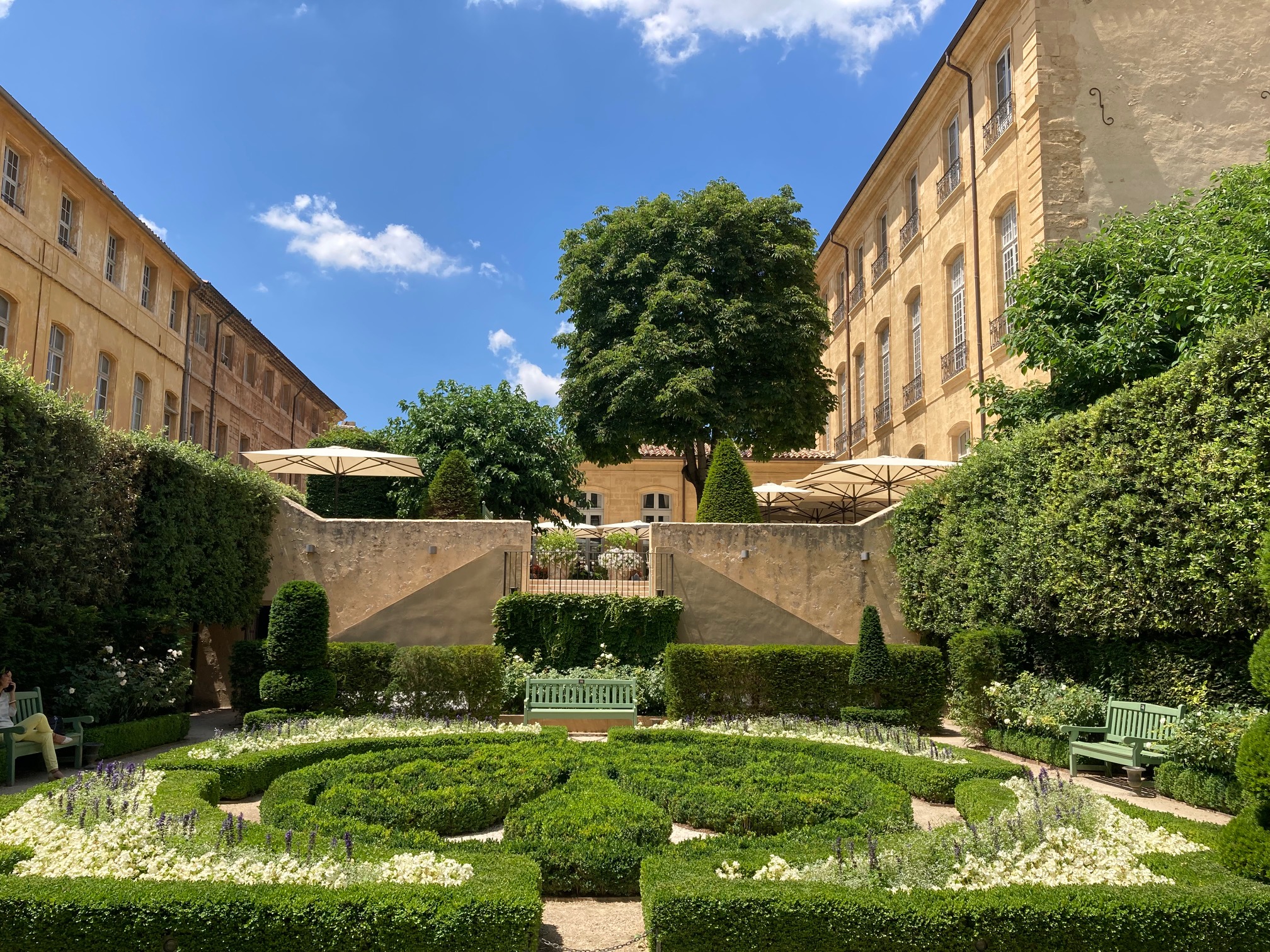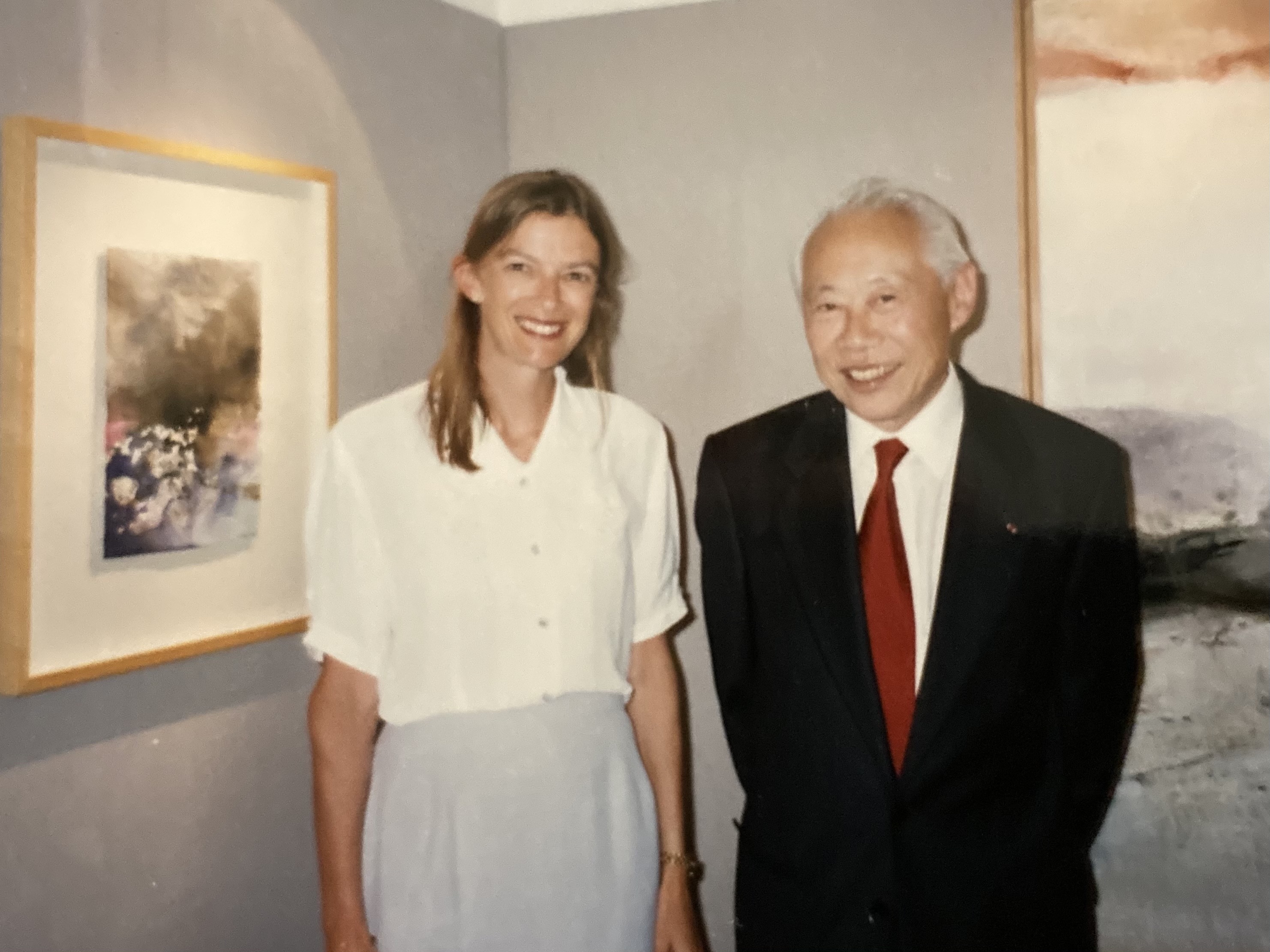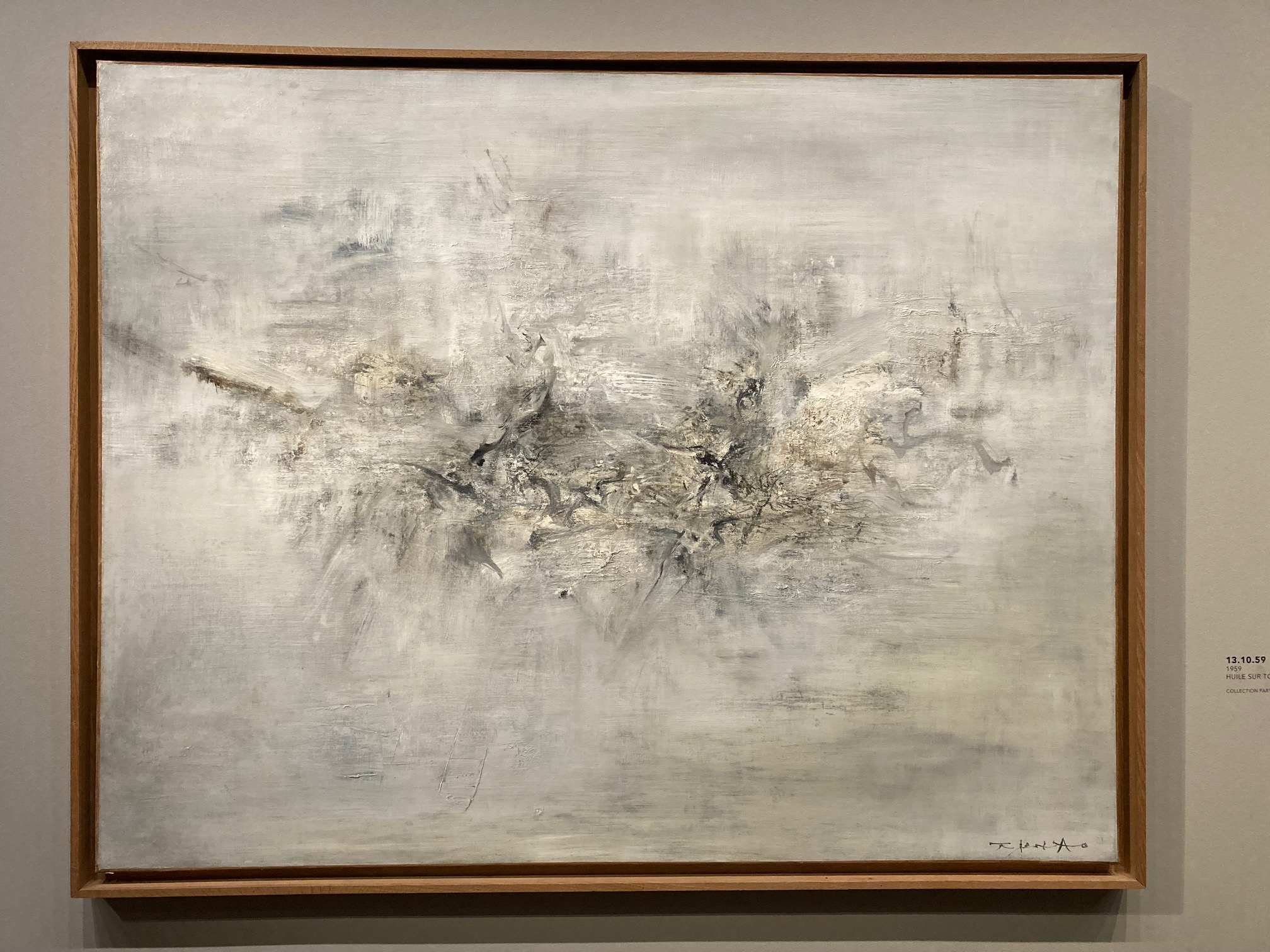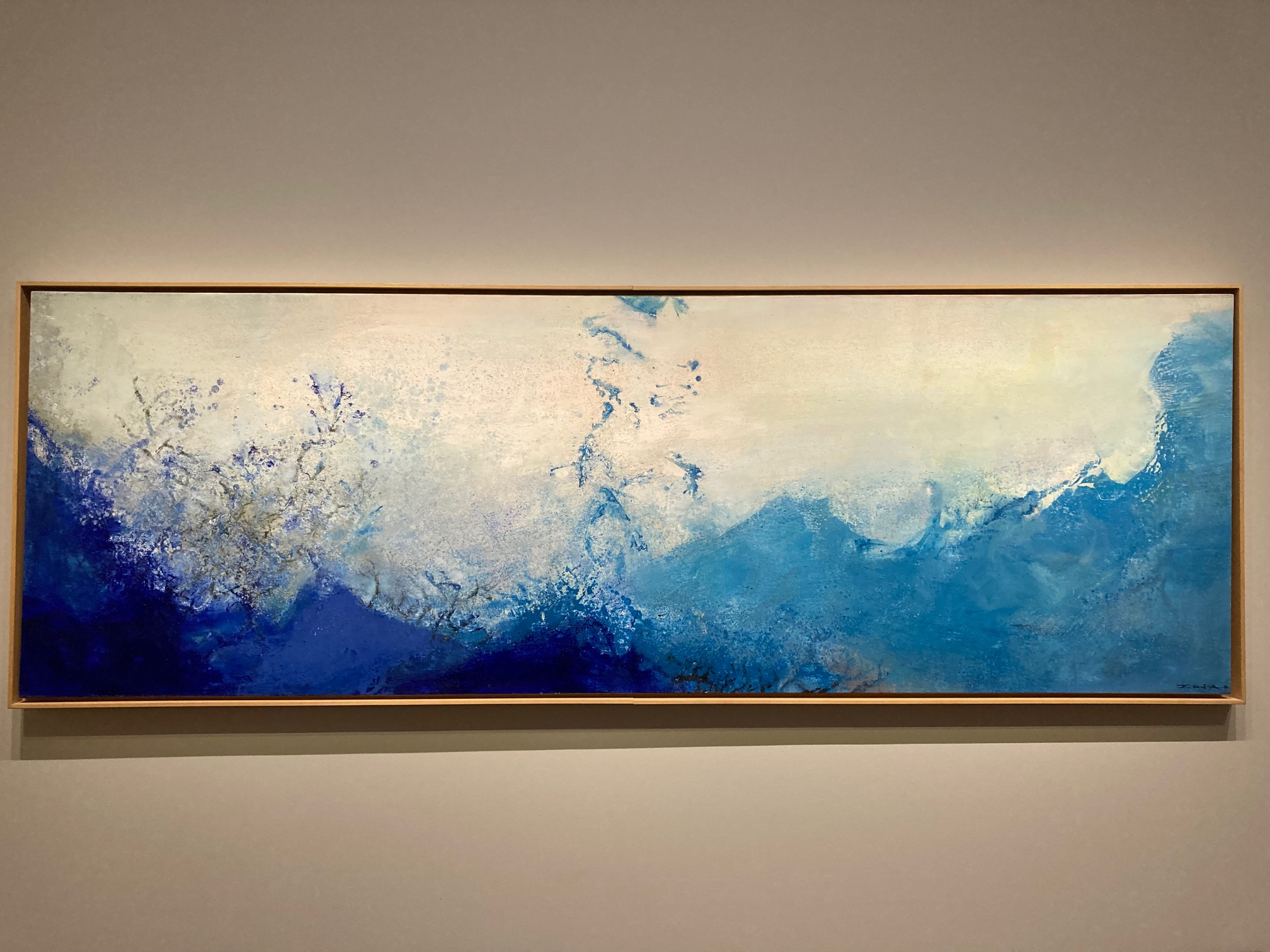藝評
Zao Wouki: “Il ne fait jamais nuit” (“It never gets dark”)
貝卉玲 (Hilary BINKS)
at 8:35pm on 10th February 2022





Captions 圖片說明
1. Zao Wouki, 3. 12. 74, oil on canvas, 250 x 260 cm, Musee d''Orleans
2. Garden of Hotel de Caumont, Aix-en-Provence
3. Art critic Hilary Binks with Zao Wouki, Alisan Fine Arts, 1996
4. Zao Wouki, 13. 10. 1959, oil on canvas, 114 x 146 cm, Private Collection, Paris
5. Zao Wouki, title unknown
Zao Wouki: “Il ne fait jamais nuit” (“It never gets dark”) was an appropriately optimistic title for an exhibition coming out of lockdown in the south of France last year. Held at the Hôtel de Caumont, an elegant 18th century mansion with a beautiful garden in the centre of Aix-en-Provence now converted into a museum, and organised in collaboration with the Zao Wouki Foundation, it gathered 80 works dating from 1935 to 2009 from public and private collections. The ensemble highlighted one of the artist’s major creative themes – the search for new forms of spatial representation of light – and was intended to show how Zao was influenced throughout his life by the genius of Aix-en-Provence’s most famous son, Paul Cézanne.
This exhibition was of more than usual interest to me, not only because of my abiding interest in Chinese art and the unique opportunity to view paintings by arguably the most renowned 20th century Chinese master, but also for a personal reason. In 1996 I was lucky enough to interview Zao Wouki when he was in Hong Kong for his exhibition “Infinite Image and Space – A Retrospective of Zao Wou-Ki” at the Hong Kong Museum of Art. Zao was already had star status and I remember lots of art writers were clamouring for the sole interview he was prepared to give. I got the story because I could talk to him in French (his English was quite limited). In this, I was helped by my friend and mentor Alice King, who held an accompanying exhibition of his smaller works at Alisan Fine Arts.
Zao Wouki (1920 -2013) lived most of his life in Paris and cut a debonair, suave figure. He was charm personified but didn’t suffer fools lightly. I have never forgotten the somewhat nerve-wracking interview, after which thankfully he wrote a kind dedication in my copy of the catalogue, which now sits among other treasured tomes on my bookshelf here in Provence. Zao belonged to the second generation of Chinese artists who went abroad in the 1940s. They followed in the footsteps of older painters like Lin Fengmian and Xu Beihong who had gone 20 years earlier. Most eventually returned to China, but Zao became fully integrated in the Western art scene and lived in Paris from 1948.
Born in Beijing in 1920 into a cultured family, Zao enrolled at the Hangzhou Institute of Fine Arts at the age of only 14. The liberal Director of the Institute, the artist Lin Fengmian, encouraged his students to question traditional concepts and be creative. Inspired by reproductions of paintings by Western artists such as Cézanne, Matisse, Chagall, Modigliani and Picasso, Zao rejected traditional Chinese painting which seemed to him merely a set of repetitive formulae. He told me how he was determined to live up to his name – “Wouki” means “no limits” or in his words “the imagination stretching to endless destinations” - and to go to France.
Arriving in Paris in 1948 after a five-week sea voyage and an overnight train from Marseilles, speaking not a word of French, Zao went straight to the Louvre, before setting about finding a room in the artists’ quarter of Montparnasse. At the Académie de la Grande-Chaumière where he took drawing lessons, Zao befriended Sam Francis, Jean-Paul Riopelle, Pierre Soulages and Hans Hartung, already well-known artists. In his small studio on the rue du Moulin-Vert, Alberto Giacometti was his neighbour and friend. In 1949, Zao met the poet Henri Michaux with whom he had an instant rapport as painting and poetry were closely linked in the Chinese tradition. The two would collaborate on a series of projects together.
A turning point in Zao’s career came during a visit to Switzerland in 1951, when he discovered the work of Paul Klee, so obviously influenced by Chinese art, which helped him to understand his own heritage better and to attempt a linear, sign-like rendition of elements. In the same way, Cézanne reminded Zao of the freehand brushwork in ancient Chinese paintings. Zao wrote, “Cézanne helped to rediscover myself as a Chinese painter.”
Zao’s work gradually veered away from the representational towards an abstraction reflecting nature and his inner emotions. From 1958, Zao’s paintings are not titled, simply dated. He said to me, “I do not like the term ‘landscape’. I prefer ‘nature’. When I paint, I am not thinking about the sky, the sea, trees… objects are irrelevant. I am thinking about light, now to paint the wind, space. This is very much a Taoist idea: the void is essential to give peace, silence.” Wandering through the exhibition in the Hôtel Caumont, this principle was evident in the mesmerizing paintings. Excitingly, I recognised one or two works from that retrospective 25 years ago in Hong Kong.
Light and space are inextricably linked in Zao Wouki’s paintings, a characteristic which was no doubt enhanced by his visits to the French Riviera, where like so many artists before and after him, he was entranced by the unique quality of the light. The world’s greatest modern artists, Picasso, Matisse, van Gogh and many others were drawn to the area by the stunning way the sunlight bathed the beautiful villages and the sea. “It is so beautiful,’ wrote Monet, “so bright, so luminous. One swims in blue air and it is frightening.” From 2004, Zao Wouki spent several summers at an estate in the Lubéron region owned by the couturier Emanuel Ungaro. He worked in the open air for the first time, painting a series of watercolours which were exhibited at the Hôtel de Caumont.
Paul Cézanne, who was born in 1839 in Aix-en-Provence and died there in 1906, was the first to use the rugged landscape of his native Provence to radically reconceive the very nature of art making. Picasso called him “the father of us all!”. Everywhere, the mountain Mont Sainte-Victoire dominated the landscape and became his favourite subject. 44 oils and 43 watercolours testify to Cézanne’s fascination with the mountain. No doubt Zao Wouki made a pilgrimage to Cézanne’s studio on the outskirts of Aix-en-Provence, which is preserved today exactly as he left it, hauntingly evocative with its pale grey walls, his easel and palette, and a collection of random porcelain vases and bottles, objects for still lifes. From the studio, it is a short walk up the Lauves hill to the viewpoint from which Cézanne painted his cherished, sunlit Mont Sainte-Victoire. I like to imagine Zao Wouki standing in that very spot.
